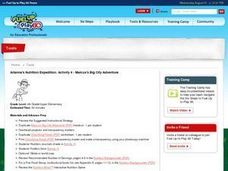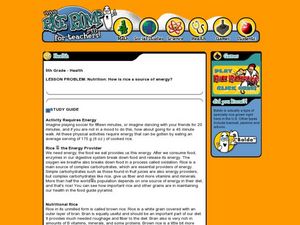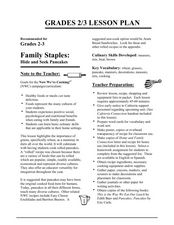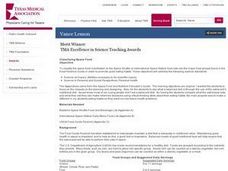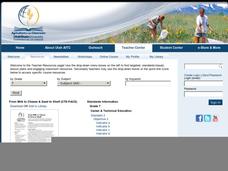Curated OER
Super K Buffet: Lesson for Kindergarten
Students determine healthy food choices. In this healthy food choice lesson, students study food vocabulary and complete a worksheet about making good choices. They put together a dinner plate that shows a complete meal using a foam...
Curated OER
Diet: Cereal Grains and Nutrition
Learners identify the nutritional value of various cereal grains. Without adding sugar, they cook with grains and compare the taste to cereal containing sugar. In addition, students complete worksheets about the different grains,...
Curated OER
Marcus's Big City Adventure
Fourth graders review their knowledge of nutrition and the 5 food groups. Then they read a story which involves food from Ethiopia, India, and Mexico. They examine these foods and their nutrients, considering the health value of each.
Curated OER
Diet: Soup and Salad Lab
Students prepare soup and salad meals and assess their nutritional and aesthetic values. After solving soup riddles and discussing types of salads, they use meal planning forms to list ingredients and recipe information. The...
Curated OER
Diversity Food Groups
Learners explore diversity in foods and people. In this diversity lesson plan, students explore diversity in foods and how things aren't always as they seem. This lesson plan is then applied to diversity in people.
Curated OER
Food Safety and Quality Assurance
High schoolers identify and interpret how milk is processed and learn important concepts in food safety and quality assurance. They identify how milk is processed, the importance of food safety, and the quality assurance process....
Curated OER
Rice as a Source of Energy
Fifth graders investigate the nutrition in rice. In this rice lesson, 5th graders discover that rice is a great source of energy. Students compare foods to rice to see the differences in the nutritional value. Students classify foods in...
Curated OER
Family Staples: Hide and Seek Pancakes
Learners cook rolled pancakes and practice culinary skills that promote an integration in a variety of foods. In this cooking lesson, students develop the skill of properly measuring and mixing ingredients . Learners then...
Curated OER
Fit With Fiber
Sixth graders investigate the nutritional value of different types of cereal. They take a survey of students that ate breakfast and create a circle graph with the results. Students examine the nutritional information on the sides of the...
Curated OER
Classifying Space Food
Students write a written summary of what they have learned about the astronaut nutritional diet in comparison with their own diet habits.
Curated OER
Foods for Better Health
Students define biotechnology and discuss the economic impact of biotechnology. They also describe what a 1015 onion and a slow-softening tomato are and how they are produced. They examine the safety of genetically-engineered or altered...
Curated OER
Understanding Food Labels
Students determine the number of calories, serving size, and vitamins and minerals in different food products and use this information to create a formula determining the number of calories per serving size and the daily percentages of...
Curated OER
Computation: How can we use rice to solve problem questions?
Fourth graders graph metric tons of rice produced by various countries. In this graphing instructional activity, 4th graders follow problem solving steps to answer questions about rice nutrition and then graph the amount of rice...
Curated OER
What's on Your Plate?
Students discover foods of the Middle East. In this global studies lesson, students sample a falafel as they follow the provided instructions to make the dish.
Curated OER
From Milk to Cheese & Seed to Shelf
Learn about food production by making cheese, seeing how a seed gets to a shelf, and discussing food safety. Budding agriculturalists complete several activities and learn about food production, biotechnology, food preservation,...
Curated OER
Build a Burger
Students read about hamburgers and analyze a healthy diet as well as the importance of nutrition. In this nutrition education lesson, students read the background information about hamburgers and their nutrition facts. Students complete...
Curated OER
Eggs, Baked Eggs Lab, Day 2
Students examine the structure, sizes and nutritional value of eggs. After completing a word search, they participate in a lab in which they make baked eggs with bacon. To end the lesson, they test their final product and complete a lab...
Curated OER
Eggs, Egg Test, Day 6
Students review their knowledge of eggs, their structure and nutritional value. After the test, they complete an egg lab and turn in their samples to the teacher. To end the lesson plan, they determine their egg score and discuss how...
Curated OER
Source Search: Agricultural Products
Farmers just farm, right? Find out how important agricultural products are to our modern society. Learners will explore the foods, textiles, and fuels made from industrial farm goods. They'll also explore the idea of choosing an...
Curated OER
Fruit
Third graders learn the serving sizes of fruit, the nutritional value, and what to look for when buying fruit.
Curated OER
Mineral Munch
Second graders explore the sodium content in foods they eat. After observing a table setting, 2nd graders then identify items made from rock. They taste low sodium crackers and compare them to regular crackers. Students discuss the...
Curated OER
Pies: A Practical Application
Students participate in making a pie. They are to discuss the nutritional value and the different types of pies. They also answer questions from the teacher about fat and they complete a pie evaluation form.
Curated OER
Label Language
Sixth graders explore healthy eating habits by identifying food labels. In this food ingredient lesson, 6th graders discuss the nutritional facts that are available on almost all foods in America and which ingredients and content is...
Curated OER
Vary Your Veggies and Focus on Fruits
Third graders study a healthy diet. In this healthy diet lesson, 3rd graders investigate the nutritional value of fruits and vegetables. Students compare a healthy diet to their personal diet.


